Notes on the Read and React Offense
By Dr. James Gels, From the Coach’s Clipboard Basketball Playbook"Helping coaches coach better..."
Disclosure: This page contains affiliate links, which means that Coach's Clipboard receives a small commission (at no cost to you) if you make a purchase using these links.
The Read and React offense was developed by coach Rick Torbett (BetterBasketball.com). Below is a review of this offense, and some of my thoughts about it after having used it for a few years (varsity boys). This is by no means complete, but hopefully gives you an idea of what it's about. See Rick Torbett's Betterbasketball Read and React Offense for the complete package.
We were formerly a 3-out or 4-out motion offense team, but switched to the Read and React offense a several years ago. It basically is a motion offense, but with specific rules and "reads" for players without the ball. The player with the ball is free to do what he/she sees best... drive, shoot, or pass and cut. We get more player movement and less standing around with this offense. We can still call set plays, but if the play fails, we just fall back into the Read and React as our basic offense - Coach Gels
General Points
- Similar to but different from motion offenses. In R&R, player with ball ("initiator") has options to do multiple things. The other four players ("reactors") read and react to what the guy with the ball does, and there is only one correct off-ball movement.
- Very flexible, can use with almost any set - 3-2, 4-1, 5-out, 1-4 high, etc. Can be used in an up-tempo quick attack offense, and in transition, or in a deliberate, slow offense. You can use it as a delay offense without changing anything - just tell players "lay-ups only".
- Can be used against both man-to-man and zone defenses, so you don't need a separate zone offense.
- You can run plays, but use the R&R rules once the play breaks down or fails.
- Is a "system"... taught in 17 layers. Could start in 5th grade with layers 1 and 2, and add a layer every year as the kids progress. You can start it out with your varsity, teach first few layers and gradually add the layers as the weeks progress - makes you a better offensive team by tournament time. Varsity level players can progress through the layers more quickly given their skill level and maturity.
- Makes your defense better by having to guard the R&R every day in practice.
- Teach this offense by using R&R breakdown drills every practice, and 5-on-5.
Teaching Offense by Layers (17 layers)
Start with layer #1 and progress. Each layer must be learned before the next is added and becomes a "habit" (automatic without having to think). Each layer is taught using breakdown drills.LEVEL A - Laying the Foundation
Layer #1, Dribble-penetration
Other 4 players use "circle movement" on the perimeter and rotate to fill the spots. The direction of the dribble-drive (right or left) determines the direction of the perimeter rotation. If ball penetrates right, the circle rotates right (counterclockwise). If the ball penetrates left, the circle rotates left (clockwise).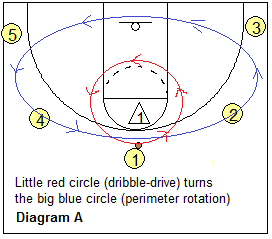
The only exception is dribble-penetration along the baseline (see below) - the opposite corner stays, so that the baseline dribbler has the option of passing to the opposite corner.
Ball options:
1. Dribble from the top - score, pitch out to corner-wing ("natural pitch") or back out to "safety valve" (back to the spot vacated by the dribbler), or dish inside. Always fill the spot where the penetrator started from, as this "safety" spot is often wide open.
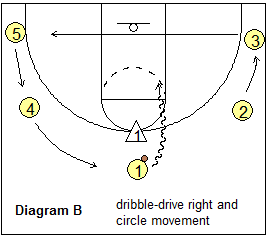
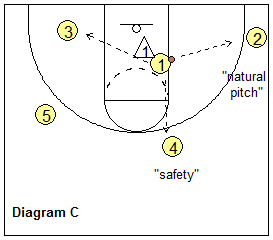
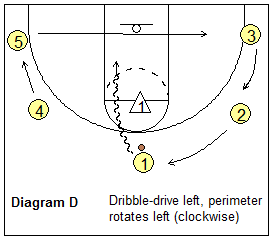
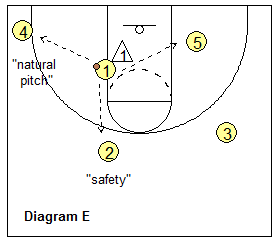
2. Wing dribble penetration - score, pitch out opposite, or dish inside.
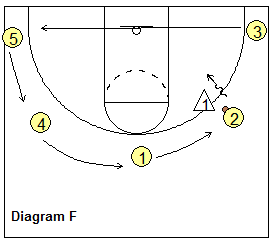
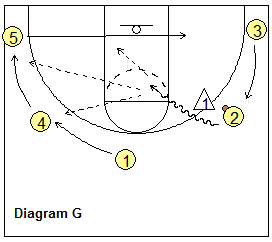
Layer #2, Baseline dribble-drive
We always want the opposite corner filled for a kick-out pass. In our perimeter rotation with baseline dribble-penetration, we want these spots filled: the "safety", a "90-degree pitch", and a "45-degree pitch", in addition to filling the opposite corner.Offense in 4-out (diagram I):
Opposite wing moves to corner.
Post rotates up to 45 degree spot.
Opposite wing rotates to 90 degree spot.
Ball-side wing rotates to vacated corner (safety).
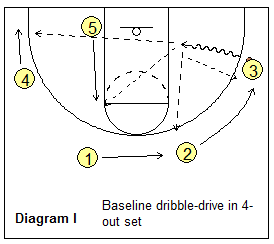
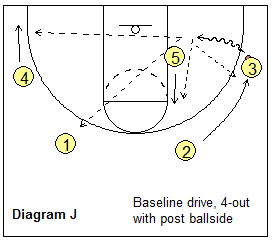
Diagram J shows the rotation when the post player is ballside. Here the post player I-cuts to the 90-degree spot, and the opposite top player (O1) stays put at the 45-degree spot, while O2 rotates to the safety spot.
Offense in 5-out (diagram H):
Opposite corner stays.
Opposite wing rotates to 45 degree spot.
Point rotates to 90 degree spot.
Ball-side wing rotates to vacated corner (safety).
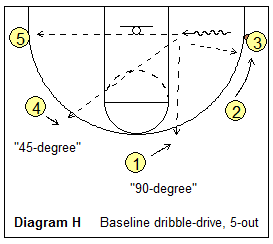
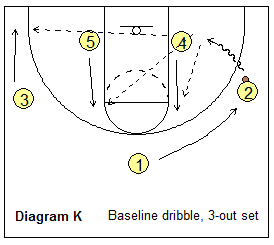
Offense in 3-out 2-in (diagram K):
Opposite wing slides down to opposite corner.
Both posts rotate up to 45 degree and 90 degree spots.
Point rotates to vacated wing-corner (safety).
Layer #3, Pass & Cut layer
Rules...1. Passer: after passing, always basket-cut on a pass 1-spot away. The basket-cut should go all the way to the hoop before filling out to the perimeter. On a perimeter pass this would be either a front cut (diagram L), or a back-cut if defender overplaying (diagram M). This cut eliminates the hedge defender once the ball is passed to the next spot. If the pass is made into the post (also just one spot away), then there will be either a Laker low cut, a Laker high cut, or a slide to the corner, or an "X-cut" (see Layer 12 below).
Note that the passer does NOT cut on a skip pass (two spots away).
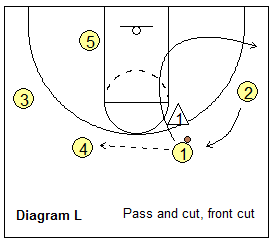
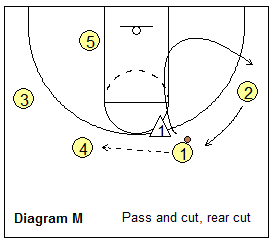
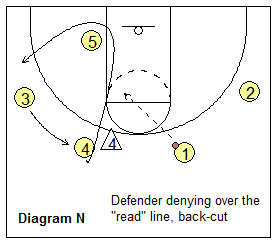
2. Pass receivers: if defender has a foot beyond the 3-point arc (aggressively denying pass), back-cut (diagram N). We call this "one foot over the read line" => back-cut. The next perimeter player over will naturally rotate into this vacated spot and is usually open.
3. After a cut, open spots are filled from the baseline up, and the basket-cutter fills the open corner spot.
Cutting Options...
After passing, a cutter may be "stood up" by the defender who impedes and prevents his cut. Instead of fighting the defender, we use coach Bob Knight's "corner" principle - the cutter simply moves sideways and screens-away (diagrams O and P).
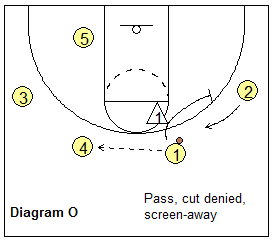
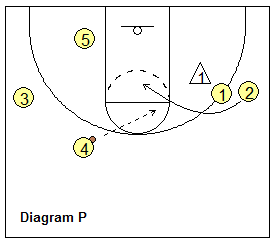
A perimeter player may wish to post up his defender inside (if he is a natural post player, or if he has a size mis-match, or if his defender is in foul trouble). Diagram N shows O4 passing, cutting inside and then "shaping up to the ball", or posting up.
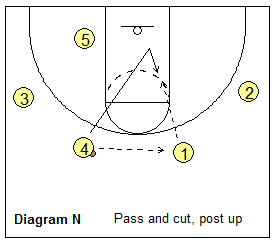
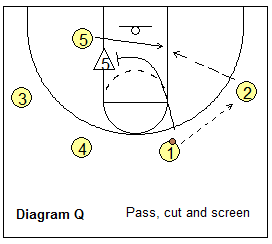
A perimeter player may pass and cut and then screen for a post player inside before filling back out to the perimeter (diagram Q). We also call this "chipping" or "bumping" the post defender. So "pass and cut" becomes "pass, cut, and screen". A perimeter player could also pass, cut and back-screen for another perimeter player (see Layer 8 below).
Layer #4, Post-player adjustment to dribble-penetration
Rules...1. If dribble comes from baseline, post slides up to elbow (diagram R).
2. If dribble comes from the top, post moves to short corner (diagram S).
3. Rules 1 and 2 apply whether post is ball-side or weak-side.
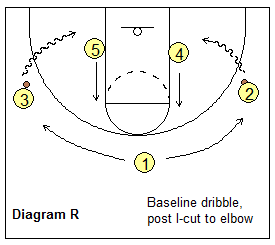
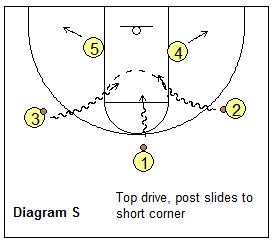
Layer #5, East-West (lateral) dribbles
Three types of East-West dribbles: speed dribble, power dribble, circle reverse dribbleDribble At, Back-cut (Lateral Speed Dribble) Rule...
1. If someone is speed-dribbling at you, back-cut to hoop (diagrams U and V). Circle movement rules apply as before.
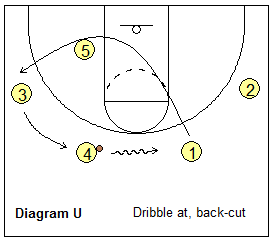
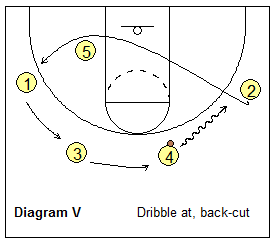
LEVEL B - Completing the Foundation
Layer #6, East-West Power (hand-off) dribble
1. Power dribble stance: dribbler turns back to basket and shuffle dribbles sideways. This has to look different than a lateral speed dribble. Player being dribbled-at V-cuts and then comes over for hand-off (diagram W), and you can run a pick and roll.2. Uses:
a. A pressure-release move.
b. A way that a post player on perimeter can get rid of ball, can pick and roll, and can get into the post. Can create mis-matches.
c. This is a way from going 5-out to 4-out to 3-out. Once post player cuts inside off the screen, he can either move out to open spot on the perimeter, or he can stay inside and post up.
b. A way that a post player on perimeter can get rid of ball, can pick and roll, and can get into the post. Can create mis-matches.
c. This is a way from going 5-out to 4-out to 3-out. Once post player cuts inside off the screen, he can either move out to open spot on the perimeter, or he can stay inside and post up.
3. If teammate fails to read the power dribble and back-cuts through (diagram X), the dribbler can keep power-dribbling to the next perimeter player (diagram Y), or reverse and dribble back to the next teammate.
4. If the defender (X1) guarding our "hand-off receiver" (O1 in diagram Z) is over the read line and denying the hand-off, O1 back-cuts for a quick pass inside.
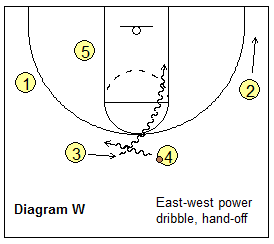
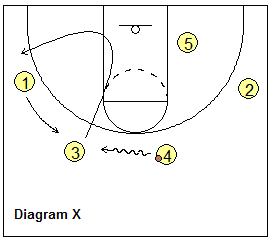
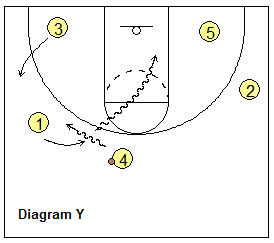
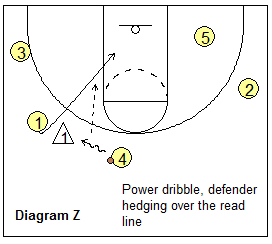
Layer #7, East-West Circle-Reverse Dribble
1. This is a response to a failed dribble-penetration. The next player, circles back for a pitch back on the perimeter, and the other players reverse their circle movement as well. This pitch back is similar to that used in the dribble-drive motion offense.2. The player receiving the pitch-back could shoot the 3, or dribble-drive to the hoop.
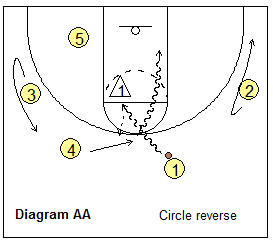
See the complete article in the members section.
Sign up now!
The complete article also includes:
- Layer #8, Back-screens
- Layer #9, Multiple Staggered Screens
- Layer #10, Advanced Post Player Reactions
- Layer #11, 4-Out, 1-in Post Blocking
- Layer #12, 4-out, 1-in Post Passing - Lakers Cuts, X-Cut, Corner Slide
- Layer #13, 3-Out, 2-in Dribble-Penetration Game
- Layer #14, Counter Help-side Defense - Pin and Skip Pass
- Layer #15, Attacking Zone Defenses - the Read and React Zone Offense
- Layer #16, Seamless Transition from Fast-break to Half-Court Offense
- Layer #17, Flowing from Set to Set
- And a detailed Animation!
Related pages:
- Read and React Offense Breakdown Drills
- 3-Out Read and React Offense
- Notes on the Read and React Zone Offense
See Rick Torbett's Betterbasketball Read and React Offense for the complete package.
Read and React Offense DVD Rentals (Hoopsking):
Read and React Offense DVD Rentals (Hoopsking):
- Read and React Offense
- Read and React Practices: Planning
- Read & React Offense Boot Camp
- Read And React Quick Hitters
- Read And React Variations
- Read And React Reaction Drills
- Read And React Zone Attack
- Read & React Youth Clinic (Layers 1-8)
- Read & React Clinic High School (Layers 7-14)
- Read & React Clinic Advanced Layers